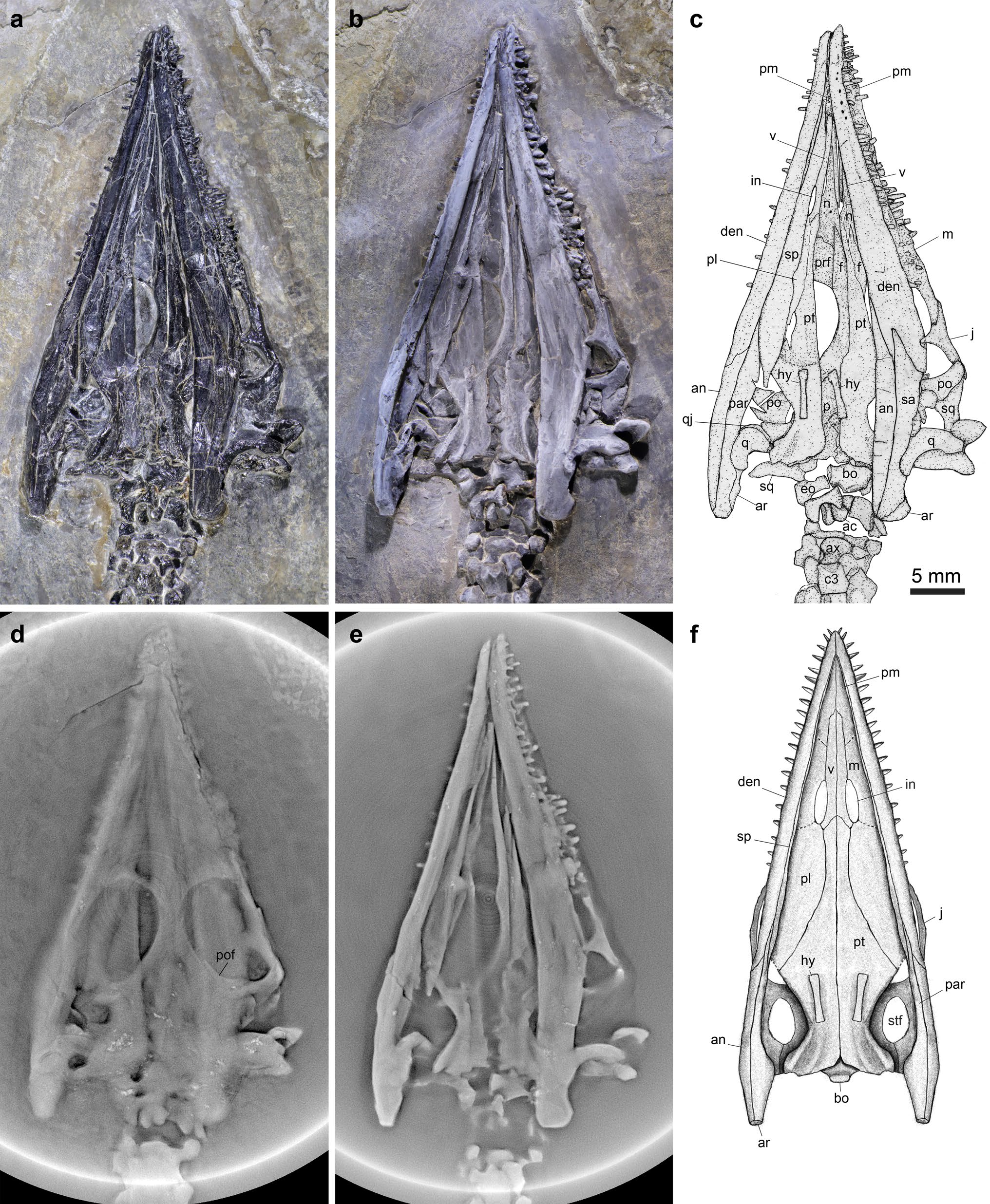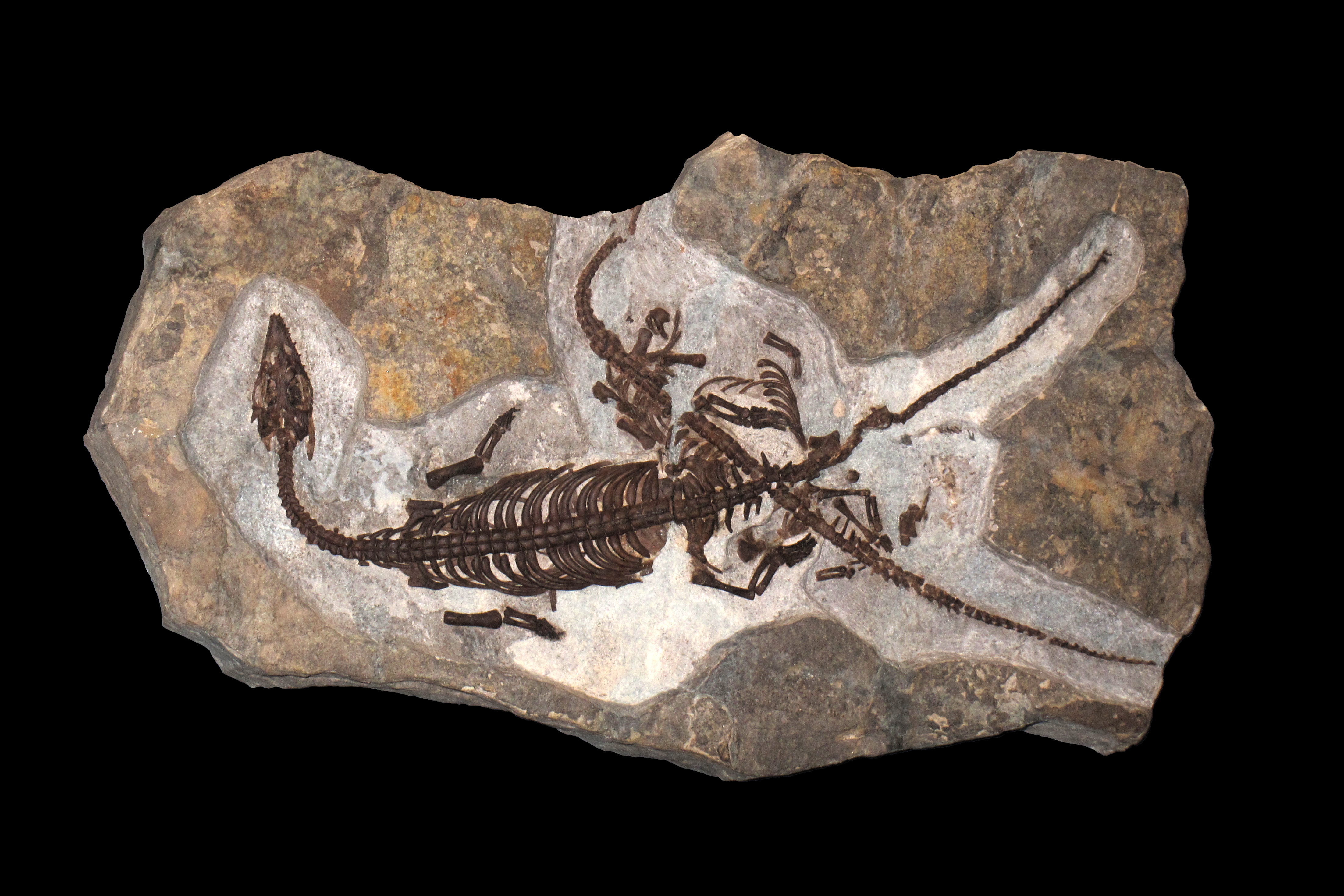|
Pachypleurosaurs
left, 220px, '' Pachypleurosaurus'' Pachypleurosauria is an extinct clade of primitive sauropterygian reptiles that vaguely resembled aquatic lizards, and were limited to the Triassic period. They were elongate animals, ranging in size from , with small heads, long necks, paddle-like limbs, and long, deep tails. The limb girdles are greatly reduced, so it is unlikely these animals could move about on land. The widely spaced peg-like teeth project at the front of the jaws, indicating that these animals fed on fish. In the species ''Prosantosaurus'', it was observed that they fed on small fishes and crustaceans which they devoured entirely and that its teeth regrew after they broke off. This was the first observation of tooth replacement in a European pachypleurosaur, the only other discovery of such an event was made in China. Classification Pachypleurosaurs were originally and are often still included within the Nothosauroidea (Carroll 1988, Benton 2004). In some more recent ... [...More Info...] [...Related Items...] OR: [Wikipedia] [Google] [Baidu] |
Dianopachysaurus
''Dianopachysaurus'' is an extinct genus of pachypleurosaur known from the lower Middle Triassic (Anisian age) of Yunnan Province, southwestern China. It was found in the Middle Triassic Lagerstatte of the Guanling Formation. It was first named by Jun Liu, Olivier Rieppel, Da-Yong Jiang, Jonathan C. Aitchison, Ryosuke Motani, Qi-Yue Zhang, Chang-Yong Zhou and Yuan-Yuan Sun in 2011 and the type species is ''Dianopachysaurus dingi,'' thanking a Professor Ding for his help. ''Dianopachysaurus'' is most closely related to ''Keichousaurus'', another Chinese pachypleurosaur. Both belong to the family Keichousauridae. Pachypleurosaurs are hypothesized to have originated in the eastern Tethys Ocean (South China) before spreading and diversifying in the western Tethys in what is now Europe. A large ghost lineage of eastern pachypleurosaurs has long been inferred based on the phylogeny of the group. ''Dianopachysaurus'' represents an early stage in the radiation of pachypleurosaurs and it ... [...More Info...] [...Related Items...] OR: [Wikipedia] [Google] [Baidu] |
Luopingosaurus
''Luopingosaurus'' (meaning "Luoping lizard") is an extinct genus of pachypleurosaurid sauropterygian from the Middle Triassic Guanling Formation of Yunnan Province, China. The genus contains a single species, ''L. imparilis'', known from a well-preserved, nearly complete skeleton. Discovery and naming The ''Luopingosaurus'' holotype specimen, IVPP V19049, was discovered in sediments of the Guanling Formation, dated to the Anisian age (Pelsonian substage) of the middle Triassic period, in Luoping County, Yunnan Province, China. This specimen consists of a nearly complete, ventrally-exposed, articulated individual, lacking only the end of the tail. The preserved portion of the skeleton measures long. In 2023, Xu ''et al''. described ''Luopingosaurus imparilis'', a new genus and species of pachypleurosaurid, based on these fossil remains. The generic name, "''Luopingosaurus''", combines a reference to the type locality in Luoping County with the Greek word "saurus", meaning ... [...More Info...] [...Related Items...] OR: [Wikipedia] [Google] [Baidu] |
Keichousaurus
''Keichousaurus'' (key-cho-saurus) is a genus of marine reptile in the pachypleurosaur family which went extinct at the close of the Triassic in the Triassic-Jurassic extinction event. The name derives from Kweichow (now Guizhou Province) in China where the first fossil specimen was discovered in 1957. They are among the most common sauropterygian fossils recovered and are often found as nearly complete, articulated skeletons, making them popular among collectors. ''Keichousaurus'', and the pachypleurosaur family broadly, are sometimes classified within Nothosauroidea, but are otherwise listed as a separate, more primitive lineage within Sauropterygia. Description ''Keichousaurus'', like all sauropterygians, was highly adapted to the aquatic environment. Most specimens had small body, males sexually mature with snout-vent length (SVL), and in females by SVL. Mean SVL for mature males is approximately SVL, and for mature females, at most SVL. It had both long necks and lo ... [...More Info...] [...Related Items...] OR: [Wikipedia] [Google] [Baidu] |
Serpianosaurus
''Serpianosaurus'' is an extinct genus of pachypleurosaurs known from the Middle Triassic (late Anisian and early Ladinian stages) deposits of Switzerland and Germany. It was a small reptile, with the type specimen of ''S. mirigiolensis'' measuring long. Fossils of the type species, '' S. mirigolensis'', have been found from the middle Grenzbitumenzone, the oldest strata of Monte San Giorgio, Switzerland, an area well known for its abundant pachypleurosaur remains. The locality dates back to sometime around the Anisian/Ladinian boundary of the Middle Triassic, around 242 Ma, with ''Serpianosaurus'' most likely occurring strictly during the latest Anisian. This makes it the one of the oldest sauropterygians from Monte San Giorgio, with only the rare pachypleurosaur ''Odoiporosaurus'' being older. Certain aspects of its morphology also suggest it is one of the most basal forms. Cajus G. Diedrich in 2013 described and named a second species, ''S. germanicus'', based on a postcra ... [...More Info...] [...Related Items...] OR: [Wikipedia] [Google] [Baidu] |
Honghesaurus
''Honghesaurus'' is an extinct genus of pachypleurosaur from the Anisian-age Guanling Formation of China. The type specimen measures about in total body length. Classification The cladogram below follows Xu and colleagues (2022), when they used ''Youngina'' as a reference point for rooting the tree. Using a selection of placodont Placodonts (" Tablet teeth") are an extinct order of marine reptiles that lived during the Triassic period, becoming extinct at the end of the period. They were part of Sauropterygia, the group that includes plesiosaurs. Placodonts were genera ...s resulted in a less resolved topology. References Triassic sauropterygians Pachypleurosaurs Fossil taxa described in 2022 Anisian life {{triassic-reptile-stub ... [...More Info...] [...Related Items...] OR: [Wikipedia] [Google] [Baidu] |
Majiashanosaurus
''Majiashanosaurus'' is an extinct genus of pachypleurosaur or alternatively a basal eosauropterygian known from the Early Triassic ( Olenekian age) of Anhui Province, eastern China. It contains a single species, ''Majiashanosaurus discocoracoidis''. Discovery ''Majiashanosaurus'' is known solely from the holotype AGM-AGB5954, a nearly complete and articulated postcranial skeleton missing, apart from the skull, some neck vertebrae and a small portion of the tail. This long skeleton is exposed in ventral view, i.e. from below, and preserves the last three neck vertebrae together with 19 back, three sacral, and more than 18 tail vertebrae, as well as pectoral and pelvic girdles, most of the forelimbs and hindlimbs, and ribs. AGM-AGB5954 was collected at Majiashan, Chaohu of Anhui Province, from the Upper Member of the Nanlinghu Formation, dating to the late Olenekian stage (Spathian) of the late Early Triassic, about 248 million years ago. The ichthyopterygian ''Chaohus ... [...More Info...] [...Related Items...] OR: [Wikipedia] [Google] [Baidu] |
Qianxisaurus
''Qianxisaurus'' is an extinct genus of pachypleurosaur or alternatively a basal eosauropterygian known from the Middle Triassic (Ladinian age) of Guizhou Province, southwestern China. It contains a single species, ''Qianxisaurus chajiangensis''. Discovery ''Qianxisaurus'' is known solely from the holotype NMNS-KIKO-F044630, a nearly complete and articulated skeleton missing only the tip of the tail and the right hindlimb, housed at the National Museum of Natural Science in Taichung, Taiwan. The holotype is exposed mostly in a view from above, with the tail gradually turning to left side view. The skull measures at in length, and the total length of the individual is estimated to have been over . Only the first 31 tail vertebrae are preserved, out of at least 42-48 vertebrae that are expected to comprise the tail based on other closely related pachypleurosaurs, which implies a total body length longer than 80 cm for this individual. NMNS-KIKO-F044630 was discovered in 2006 ... [...More Info...] [...Related Items...] OR: [Wikipedia] [Google] [Baidu] |
Anarosaurus
''Anarosaurus'' is an extinct genus of pachypleurosaurs that lived in the Middle Triassic period (Anisian) and has been found in the Jena Formation and the Karlstadt Formation of Germany and the Winterswijk Quarry ( Lower Muschelkalk) of The Netherlands. Two species are known: ''A. pumilio'' (the type species) and ''A. heterodontus''. The holotype of ''A. pumilio'' was originally housed at the Institut und Museum fur Geologie und Palaontologie, Georg-August-Universitat, Gottingen, but can no longer be located today because it was lost or destroyed during World War II. ''Anarosaurus'' was a small reptile with an estimated body length of . See also * List of plesiosaurs This list of plesiosaurs is a comprehensive listing of all genera that have ever been included in the order Plesiosauria, excluding purely vernacular terms. The list includes all commonly accepted genera, but also genera that are now considered inv ... References Triassic plesiosaurs Extinct animals of ... [...More Info...] [...Related Items...] OR: [Wikipedia] [Google] [Baidu] |
Dactylosaurus
''Dactylosaurus'' is a genus of nothosaur in the family Pachypleurosauridae. Along with '' Anarosaurus'', ''Dactylosaurus'' was one of the earliest known pachypleurosaurs to come from Europe.Lepidosauromorpha: Pachypleurosauridae: Dactylosaurus & Anarosaurus Palaeos.com. Last accessed 2008-07-04. Etymology ''Dactylosaurus'' comes from the ' (), "" and ' (), meaning "" or ...[...More Info...] [...Related Items...] OR: [Wikipedia] [Google] [Baidu] |
Fish
Fish are aquatic, craniate, gill-bearing animals that lack limbs with digits. Included in this definition are the living hagfish, lampreys, and cartilaginous and bony fish as well as various extinct related groups. Approximately 95% of living fish species are ray-finned fish, belonging to the class Actinopterygii, with around 99% of those being teleosts. The earliest organisms that can be classified as fish were soft-bodied chordates that first appeared during the Cambrian period. Although they lacked a true spine, they possessed notochords which allowed them to be more agile than their invertebrate counterparts. Fish would continue to evolve through the Paleozoic era, diversifying into a wide variety of forms. Many fish of the Paleozoic developed external armor that protected them from predators. The first fish with jaws appeared in the Silurian period, after which many (such as sharks) became formidable marine predators rather than just the prey of arthropods. Mos ... [...More Info...] [...Related Items...] OR: [Wikipedia] [Google] [Baidu] |
Swissinfo
SWI swissinfo.ch is a multilingual news and information platform produced by the Swiss Broadcasting Corporation (SRG SSR). Its content is Swiss-centred, with top priority given to in-depth information on politics, the economy, the arts, science, education, and direct democracy. Switzerland's international political, economic and cultural relations are other key points of focus. The website is available in ten languages. History In the mid-1990s, economic circumstances forced swissinfo.ch to take a new strategic direction. The internet was advancing fast, heralding a new era for the producing journalists and the Swiss Radio International (SRI) audience alike. The German, French, English and Portuguese sites went online in 1999. The Italian, Japanese and Spanish sites followed in 2000, with Arabic going live on 1 February 2001 and Chinese in September of the same year. Within just two years, the internet platform for expatriate Swiss was already better known than SRI's short-wav ... [...More Info...] [...Related Items...] OR: [Wikipedia] [Google] [Baidu] |



